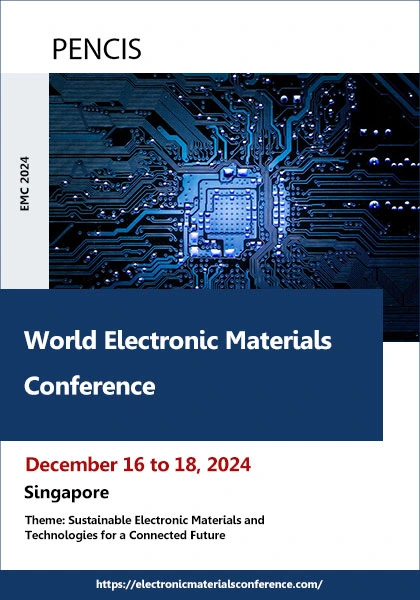Electronic Materials Conference: Shaping the Future of Technology and Innovation
Being ahead of the curve is essential to comprehending new developments in the ever changing field of electronics. An electronic materials conference can help with that. Experts, researchers, and business executives gather at these gatherings to discuss the most recent developments in materials science and how they apply to electronics. Anyone interested in the future of technology should attend an electronic materials conference, which covers everything from advanced semiconductors to the newest flexible display technology.
Attending an electronic materials conference provides a special chance to network with like-minded people, acquire insightful knowledge, and uncover fresh concepts that may influence the development of the future generation of electronic devices, regardless of your level of experience. The best brains come together to explore the future of materials that power everything from smartphones to electric vehicles in this collaborative and inspiring environment.
The Importance of an Electronic Materials Conference
A symposium on electronic materials is essential to determining how technology will develop in the future. These gatherings give researchers, innovators, and business executives a forum to talk about developments in the materials that underpin contemporary electronics. The conference emphasizes how the most recent developments in materials science can enhance electrical gadgets, making them faster, more effective, and more sustainable.
Experts discuss a variety of subjects at these conferences, ranging from conductive polymers and semiconductors to the new field of nanomaterials.
In fields that are vital to sectors like consumer electronics, renewable energy, and medical technology, this interdisciplinary cooperation generates fresh concepts and advances advancement. Professionals may stay up to date on the latest research and the innovations that will influence the future by attending an electronic materials conference.
Additionally, networking opportunities that result in alliances, joint research projects, and possible business endeavors are fostered by these events. Being ahead of the competition is crucial in this fast-paced sector, and the electronic materials conference is a place to acquire the skills and contacts that could result in success and new discoveries.

Key Topics Discussed at Electronic Materials Conferences
Participants in an electronic materials conference delve deeply into the most fascinating and pertinent subjects in materials research. The creation of sophisticated semiconductors is one of the fundamental topics that is frequently studied. Modern electronics rely heavily on semiconductors, and advancements in this field—such as increased efficiency and lower sizes—have a direct impact on everything from high-performance computer systems to smartphones.
Materials for energy conversion and storage are another popular topic at these conferences. Materials with improved energy storage and management capabilities are becoming more and more necessary as electric cars and renewable energy technologies gain traction.
At these gatherings, researchers present the most recent developments in energy-efficient materials, supercapacitors, and battery technology—all of which are crucial in forming a sustainable future.
Electronics that are printable and bendable have also become a hot topic. Wearables, smart textiles, and even foldable screens are made possible by the development of lightweight, bendable electronics. Experts can debate the development of these novel materials and their possible uses in commonplace products during an electronic materials conference.
Emerging Trends in Electronic Materials
Conferences like this offer a crucial glimpse into the future of the constantly changing field of electronic materials. The utilization of 2D materials is one of the most intriguing trends in the industry. Devices that are faster, smaller, and more energy-efficient could be made possible by these incredibly thin materials. 2D materials have enormous promise for use in high-speed electronics and quantum computing, and their discovery marks the start of a new age in technology.
The emergence of bioelectronics is another new trend that is covered at these conferences. These materials provide novel possibilities in wearables, diagnostics, and therapeutics by directly interacting with biological systems.The way we use technology in our daily lives, monitor health, and provide therapies could all be completely changed by bioelectronics.
Last but not least, research on electronic materials has begun to place a greater emphasis on sustainability. Scientists are putting a lot of effort into creating more recyclable or reusable materials as the environmental impact of electronic trash keeps increasing. Participants in an electronic materials conference talk about how sustainable materials and green technology are changing the electronics sector and lowering its carbon footprint.
Networking Opportunities at Electronic Materials Conferences
Making connections with professionals from around the world is one of the biggest advantages of going to an electronic materials conference. These gatherings bring together a wide range of people, such as academics, researchers, business executives, and innovators, fostering a vibrant atmosphere for networking and cooperation. Attendees can exchange expertise, talk about difficulties, and come up with solutions to the most important issues facing the industry by interacting with professionals in the sector.
The purpose of workshops, panel discussions, and casual networking events is to promote contact among participants. These environments offer a rare chance to discuss ideas with professionals, find out about current studies, and perhaps establish collaborations that might result in ground-breaking work.The electronic materials conference is a great location to make contacts that can spur future innovation, whether it’s over a formal networking dinner or an informal coffee break.
These gatherings build a sense of community within the sector in addition to professional relationships. In addition to learning, participants frequently come back year after year to rekindle their relationships with mentors and coworkers. These gatherings can lead to ongoing discussions and collaborations that could shape the future of the entire area of electronic materials.
The Future of Electronic Materials Conferences
The format and subject of conferences on electronic materials will change along with the technology landscape. These events are expected to become increasingly more participatory and captivating in the future, as the emergence of virtual platforms facilitates participation by audiences around the world. It is anticipated that hybrid conferences—which blend virtual and in-person experiences—will become more commonplace, making them more accessible to participants from any location.
Furthermore, future conferences will probably focus even more on green technologies and their effects on the environment as the need for innovative and sustainable electronic materials increases.Undoubtedly, the increased emphasis on sustainability in the field of materials science will spark more conversations about environmentally suitable substitutes and recycling techniques, assisting in the development of a more conscientious electronics sector.
In the future, the electronic materials conference will remain a crucial event for all those working in the materials science field. These occasions will continue to be at the forefront of innovation as new technology and research advances, motivating the following wave of electrical discoveries.







